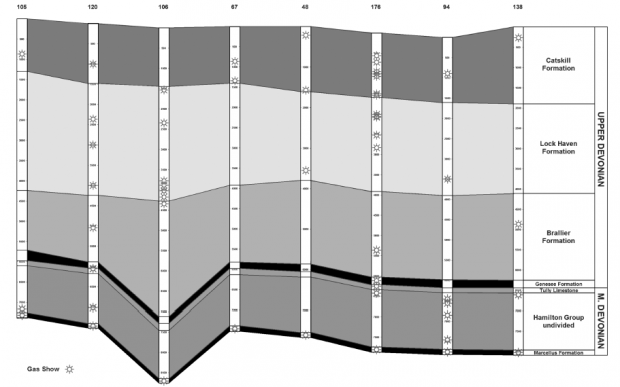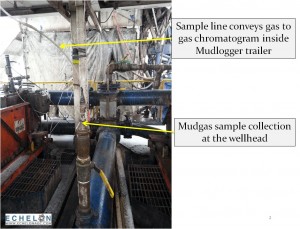New study details methane’s complexity in Northern Tier geology
-
Laura Legere

Baldassare et al. / AAPG Bulletin
A figure from Fred Baldassare’s paper in the AAPG Bulletin depicts gas pockets, or shows, throughout the subsurface in the Northern Tier. / AAPG Bulletin
Rural homeowners with sputtering faucets know that methane sometimes seeps into Pennsylvania groundwater naturally. Other times, the gas finds a path to drinking water supplies through flawed natural gas wells.
Telling the natural condition from the man-made one is a key task of regulators and companies investigating complaints of methane contamination in northeastern Pennsylvania, where the majority of drilling-related stray gas cases have originated in recent years. But how much can the gas found in a water well reveal about where it came from?
This week researchers released new findings, based on what they said is the largest published geochemistry database in the Appalachian basin, that detail the natural occurrence and distinctive features of methane tucked into the thousands of feet of rock between the surface and the Marcellus Shale in five Northern Tier counties.
The data, published in the Bulletin of the American Association of Petroleum Geologists, reinforce the common understanding of what methane trapped at different depths generally looks like. But the authors also found surprising exceptions where methane in shallower rock layers bore marks more often seen in Marcellus Shale methane, casting doubt on the use of some hallmarks to tell them apart.
The study has implications for regulators and companies trying to determine how methane in a water well got there and whether natural gas drilling is at fault.
“The system is a lot more complex than other publications have been able to reveal,” Fred Baldassare, the paper’s lead author, said.
“We always have to investigate these alleged incidents — and some of them are real — at a very site-specific level,” he said. “You can’t just look at the chemistry by itself.”
Of mud and methane
Baldassare used to work for the Department of Environmental Protection investigating cases where stray gas migrated into homes or water supplies, and he now runs the firm Echelon Applied Geochemistry Consulting.
He and researchers with the Pennsylvania Geological Survey and the firm Weatherford Laboratories analyzed the methane and ethane in more than 2,300 gas and water samples, taken from 67 private water wells before drilling began nearby and from 234 natural gas wells as companies drilled into the Marcellus Shale in Tioga, Bradford, Susquehanna, Sullivan and Wyoming counties.

Fred Baldassare / Echelon Applied Geochemistry Consulting
A diagram shows how researchers collected gas samples from drilling mud at well sites.
The mud that circulates in a well during drilling carries some of the methane from each gas pocket it hits back to the surface, where it can be analyzed. For the study, the researchers took samples of each of those gas pockets and analyzed their stable carbon and hydrogen isotopes, a kind of chemical fingerprinting process that reveals how the gas was formed and clues about where it came from.
Researchers have long known that methane formed by heat and pressure deep underground, called thermogenic methane, looks different than the biogenic or microbial methane created by the decay of organic matter near the surface. Some people assume that methane that naturally occurs in well water is microbial while thermogenic methane comes from leaky gas wells, but that is not the case in Pennsylvania.
Baldassare and his co-authors found thermogenic gas in 88 percent of the water supply wells they examined and microbial or a mix of gases in the other 12 percent. (The researchers picked out all the water wells with isotope data from a larger baseline groundwater-quality database.) By studying the gas well logs, they learned that thermogenic gas is embedded in the rock layers used as aquifers in the region from natural or, potentially, man-made sources unrelated to shale gas development.
“When future isotope data show a stray gas in this area to be thermogenic, that finding cannot be the sole basis for alleging that the stray gas was caused by oil or gas-well drilling,” the authors wrote.
“Expect the exception”
All thermogenic gas is not alike. Generally, the deeper you dig the likelier you are to find drier methane that has been exposed to higher temperatures, or is more “mature.” In the study region, the average thermogenic gas in the first 1,000 feet underground is less mature and has a different isotopic signature than the average “postmature” thermogenic gas found in and around the Marcellus more than 5,000 feet deep, the study found.
Ethane, a sister hydrocarbon to methane, offers a second signal of the differences between the deep and shallow thermogenic gas. Generally, the carbon isotopes of ethane in natural gas are heavier than the carbon isotopes of methane, but in shales like the Marcellus the trend switches and the methane isotope is heavier, in what is known as an isotope reversal. This characteristic reversal has been used to help identify deeper gases.
Although those rules held up in the study, the exceptions the researchers found were remarkable: some shallow gas samples showed evidence of mixing with gas that had seeped up from deeper layers over millions of years, so they looked similar to the gas found in the Marcellus Shale. In a surprising finding, the authors saw isotope reversals in about a quarter of the shallow gas samples collected from wells during drilling. The reversals appeared inconsistently, showing up in a gas pocket about 400 feet deep in one well, for example, but not in another at similar depth in a well 10 miles away.
“If it was just a few data points that showed this reversal that we see in the shallow stuff, you could say that’s just noise,” Baldassare said. “But it’s repeatable over and over again.”
The differences between the average and the exceptional shallow methane should remind researchers to be cautious about their interpretations, he said. “People need to be careful about drawing these broad generalizations about the data, and making snap judgments about this, which I think has gone on with limited data sets.”
“In science, we should always expect the exception,” he added later.
The study proves the value of having a comprehensive picture of the naturally occurring methane in aquifer systems before drilling begins, said Christopher Laughrey, a senior geosciences advisor with Weatherford Laboratories, who reviewed an early version of the study. That lesson has applications far beyond Pennsylvania as the combination of horizontal drilling and hydraulic fracturing opens new areas of the world to oil and gas development.
An extensive database, he said, “lets you, right up front, not just discriminate gases from different sources but even anticipate the problem.”
Knowing that gas naturally occurs in a region – even knowing what it looks like and where it is found – is not necessarily a “get out of jail free card” for companies who face complaints from nearby water well owners, Baldassare said.
“Even if the isotope signatures look the same, you could still have created a disturbance that causes a problem,” he said. “You still have to do an investigation.”
















